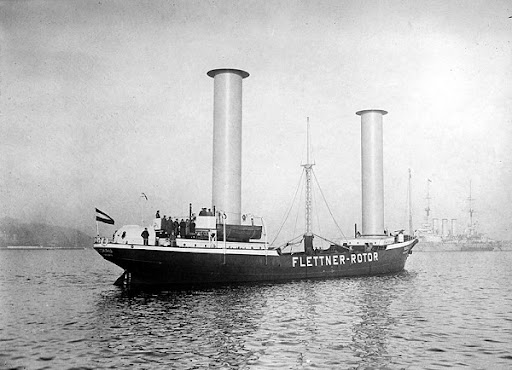A very interesting vessel, the E-Ship 1, has just gone into service in Europe.

She's what's called a rotor ship or Flettner ship (after their inventor, Anton Flettner). She's powered by conventional diesel engines; but as well as driving the propellers directly, their exhaust turns four rotorsails which rise high above the deck. They use the Magnus effect to propel the ship forward, in addition to the thrust of the propellers, and thus save a considerable amount of fuel.
Flettner developed a prototype of the rotor ship as early as 1925, called the Buckau. She relied on two rotorsails for propulsion, driven by a 50hp. electric motor.

Buckau in 1925 (image courtesy of Wikipedia)
The prototype successfully crossed the Atlantic, and attracted considerable interest in America: but in the 1920's, technology was not sufficiently developed to make rotorsails an economical proposition. Flettner went on to design a number of helicopters for Germany, including the FL 282 Kolibri, which the German Navy ordered in large quantity late in World War II. Unfortunately for them, Allied bombing disrupted preparations for mass production. Only about 30 were built, of which examples were brought back to the USA after the war for evaluation. Flettner followed, establishing an aircraft company here, and influencing the design of Kaman helicopters during the 1950's. He died in 1961.
Rotorsails can propel vessels on their own, without an engine, or can be used in the same way as aboard the E-Ship 1, as a hybrid propulsion system. The assistance provided to propulsion by the rotorsails might mean that a ship so equipped would burn a lot less fuel than one relying on conventional propulsion alone. If the E-Ship 1 proves successful, it might prove a very important step forward for merchant shipping in general.
Peter
3 comments:
I'be often wondered if some form of sailing cargo vessel might be practical today; especially the proposal to use giant steerable mites for sails.
If it works, and fits under bridges, then I'm all for the idea. It seems like an elegant solution.
Jim
Gerald:
Steerable mites? Do they take a bit or neck rein?
WV splegra- like splenda but with more grassy fiber.
Post a Comment